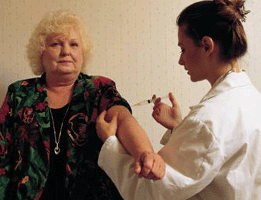Kristi M. Saunders, MD, MS, FACOG, NCMP
 We have all heard about a family member or friend who had shingles, yet how many of us really know what it is?
We have all heard about a family member or friend who had shingles, yet how many of us really know what it is?
“Is it contagious?”
“Only cancer patients get that, right?”
“I never had chickenpox so I don’t have to worry, right?”
Let’s review some quick facts about this disease and then go over information regarding prevention, treatment, and new insights to help us know how to prepare for it.
What is shingles?
Shingles is a condition caused by the same virus responsible for chickenpox (herpes zoster). Over 90% of North Americans are infected with herpes zoster, which means we have been exposed to it and have evidence of the virus in our bloodstream. One out of three people will not get a rash. Perhaps as a child you only had a fever, runny nose, and body aches. But after exposure, the virus travels, hides, and lives quietly in your nerve cells called neurons. Studies suggest that the virus prefers special neurons called ganglions in our upper body that control pain in our upper trunk, chest, and face.
Years later, when conditions are right, the virus can “wake up,” reproduce itself, and travel to the skin by way of sensory nerve fibers resulting in an incurable, burning, painful, blister-like rash. Usually, the pain and blisters are on one side of the upper or lower back, chest, abdomen, or face. Days to months prior to the blisters, there is burning pain (like a sunburn), and the rash arrives lasting 7 to 10 days. A more serious subset of the disease, herpes zoster ophthalmicus, affects the face and eye, causing pain and visual problems, and the loss of independent living for older sufferers. The blisters and pain can be treated by pain and antiviral medications, which shorten the course of the virus and help prevent a chronic pain syndrome called postherpetic neuralgia (PHN).
Who gets shingles?
Although once thought to occur only in those with cancer or immunodeficient syndromes (diseases that make it hard to fight off viruses), we now know that over 50% of people who live to age 85 will be affected by shingles. Changes in our cellular immunity occur with age, stress, certain medications, and hormones, and make us more vulnerable to viruses, especially those in the herpes family (shingles, herpes simplex, cytomegalovirus). Recent studies have shown that adults with lung diseases such as COPD (chronic obstructive pulmonary disease) or asthma who use inhaled or oral steroids are more apt to get shingles because they suppress our cellular immunity. Women, particularly during the menopause transition, have higher rates of shingles than men, most likely due to hormonal changes to their immune response. These changes at menopause can increase the rate of many immune-related diseases (such as heart disease, diabetes, arthritis, multiple sclerosis).
Postherpetic neuralgia
Preventing and treating shingles has more to do with the prevention of PHN, which damages nerve fibers caused by the reawakening virus. PHN is diagnosed when pain outlasts the rash for more than 3 months. It may last for years. Overall, one out of 10 shingles sufferers will also get PHN. The younger the patient at first outbreak of shingles the higher the risk of getting PHN. Other risk factors include being female, smoking, a previous severe case of shingles or chronic pain, or neglecting to take antiviral medications within 2 days of the start of the rash. Six out of 10 PHN sufferers are unable to return to work, costing millions of healthcare dollars for hospitalization and pain medication.
Treatment
As well as antiviral medications, treatments for long-term pain include narcotics, anti-inflammatories, antiseizure medication, antidepressants, topical patches and creams (eg, oxycodone, ibuprofen, acetaminophen, amitriptyline, lidocaine patches, capsaicin) and alternative therapies such as Reiki. Unfortunately, all have limited success and side effects.
Prevention
Are we all ticking time bombs just waiting for the inevitable outbreak? The answer is no, not all of us. First, you can’t catch this from someone else unless you have a compromised immune system. Second, shingles risk increases with increasing age. This you cannot change. Third, the FDA recently approved Zostavax, a vaccine that decreases risk of shingles and PHN by over 66% and perhaps more in younger people. The vaccine was first approved only for those over 65 with risks for shingles, but this year has been approved for those over age 50.
Most insurance companies cover the vaccine, including Medicaid and Medicare parts B and D to some extent. The cost without insurance can be up to $300 with or without the cost of administration by your doctor’s office. Studies so far show protection for 6 years and few side effects. Because some medical offices do not offer this vaccine regularly, call first. Also, review your insurance coverage.
For those who already had shingles, you have a six out 100 chance of recurrence. Additionally, there is a higher risk of recurrence in women and those with shingles prior to age 50, high stress, cancer, or HIV and immune deficiencies. To offset your risk, try to lessen stress, adopt a healthy lifestyle, and be sure to review prevention strategies with your caregiver.
Check out this website for more information about shingles and vaccines: www.cdc.gov/shingles.
Photo credit: Copyright © Microsoft. Used with permission.